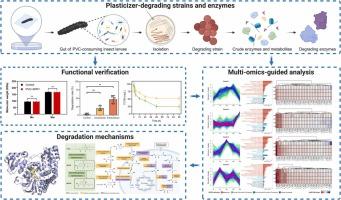多组学指导下广谱增塑剂降解剂红球菌sp. SPR1和降解Tris(2-乙基己基)Trimellitate (TOTM)关键酶的发现
IF 11.3
1区 环境科学与生态学
Q1 ENGINEERING, ENVIRONMENTAL
引用次数: 0
摘要
塑料污染已经引起了全球的关注,但增塑剂对环境的威胁在很大程度上仍未得到充分研究。新兴增塑剂,如三(2-乙基己基)三酸盐(TOTM),越来越普遍,但其生物降解机制和相关菌株知之甚少。在这里,我们从聚氯乙烯(PVC)消耗昆虫幼虫的肠道中发现了红球菌菌株SPR1,它对五种典型的增塑剂(包括传统的和新兴的增塑剂)表现出广谱降解能力。SPR1在120小时内实现了高达63.07%的TOTM降解,其中两种酶TOTMaseA(线性初级烷基磺酸酶)和TOTMaseB (α/β水解酶)被证实是关键因素。酶动力学表明,TOTMaseA的Vmax为2.655 mM, Km为0.3821µM/min,而TOTMaseB的Vmax为0.9664 mM, Km为0.2245µM/min,证实了TOTMaseA具有更高的催化通量,是降解TOTM的主要贡献者。值得注意的是,在TOTM暴露下,TOTMaseA的丰度也始终高于TOTMaseB。环境样品中广泛存在降解totm的同源菌株和酶,强调了其生态相关性和生物修复潜力。这项研究为微生物降解TOTM提供了定量和机制上的见解,并促进了我们对酶的理解,使新兴增塑剂的分解成为可能。本文章由计算机程序翻译,如有差异,请以英文原文为准。

Multi-omics-Guided Discovery of Broad-Spectrum Plasticizer Degrader Rhodococcus sp. SPR1 and Key Enzymes Driving Tris(2-ethylhexyl) Trimellitate (TOTM) Degradation
Plastic pollution has garnered global attention, yet the environmental threats posed by plasticizers remain largely understudied. Emerging plasticizers, such as tris(2-ethylhexyl) trimellitate (TOTM), are increasingly prevalent, but their biodegradation mechanism and associated strains are poorly understood. Here, we discovered Rhodococcus strain SPR1 from the gut of polyvinyl chloride (PVC)-consuming insect larvae, which exhibits broad-spectrum degradation capabilities across five representative plasticizers, including both traditional and emerging types. SPR1 achieved up to 63.07% degradation of TOTM in 120 hours, with two enzymes TOTMaseA (linear primary-alkylsulfatase) and TOTMaseB (α/β hydrolase), validated as key contributors. Enzyme kinetics revealed that TOTMaseA exhibited a Vmax of 2.655 mM and Km of 0.3821 µM/min, while TOTMaseB showed a Vmax of 0.9664 mM and Km of 0.2245 µM/min, confirming that TOTMaseA has superior catalytic throughput and serves as the dominant contributor to TOTM degradation. Notably, TOTMaseA also displayed consistently greater abundance compared to TOTMaseB under TOTM exposure. The widespread presence of homologous strains and enzymes of TOTM-degrading SPR1 in environmental samples underscores the ecological relevance and bioremediation potential. This study provides quantitative and mechanistic insights into the microbial degradation of TOTM and advances our understanding of enzymatic strategies that enable the breakdown of emerging plasticizers.
求助全文
通过发布文献求助,成功后即可免费获取论文全文。
去求助
来源期刊

Journal of Hazardous Materials
工程技术-工程:环境
CiteScore
25.40
自引率
5.90%
发文量
3059
审稿时长
58 days
期刊介绍:
The Journal of Hazardous Materials serves as a global platform for promoting cutting-edge research in the field of Environmental Science and Engineering. Our publication features a wide range of articles, including full-length research papers, review articles, and perspectives, with the aim of enhancing our understanding of the dangers and risks associated with various materials concerning public health and the environment. It is important to note that the term "environmental contaminants" refers specifically to substances that pose hazardous effects through contamination, while excluding those that do not have such impacts on the environment or human health. Moreover, we emphasize the distinction between wastes and hazardous materials in order to provide further clarity on the scope of the journal. We have a keen interest in exploring specific compounds and microbial agents that have adverse effects on the environment.
 求助内容:
求助内容: 应助结果提醒方式:
应助结果提醒方式:


